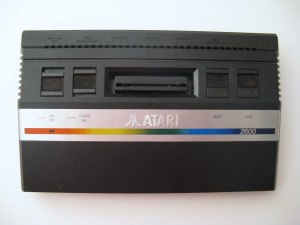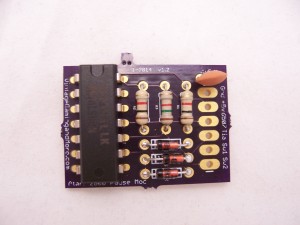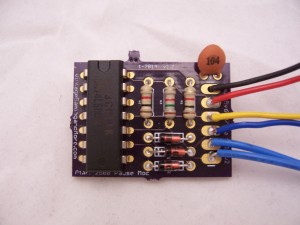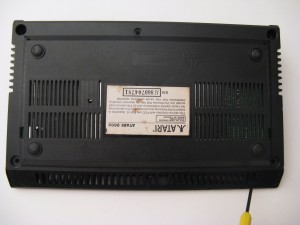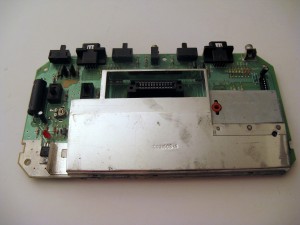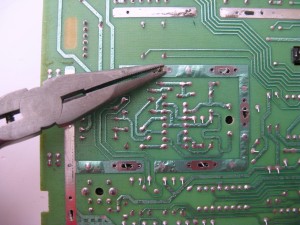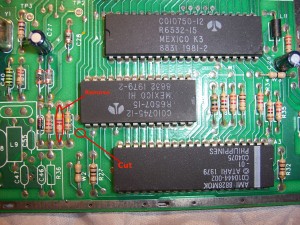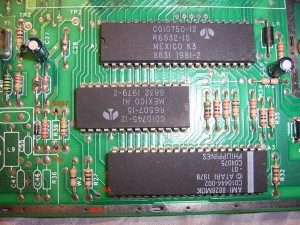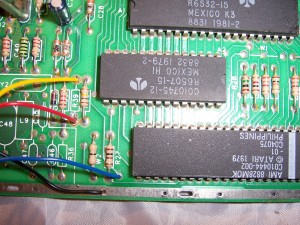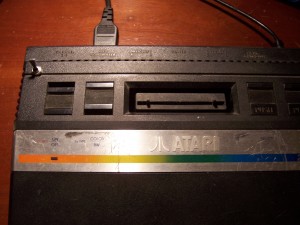Atari 2600 Jr. Pause Mod Installation Guide
Disclaimer: I am not responsible for any damage done to your Atari. This mod is designed to allow you to pause your system. The mod will work if performed correctly to a fully functioning Atari. Perform at your own risk.
Tools You Will Need
- Philips Screwdriver
- Soldering Iron and Solder
- De-soldering Tool (De-soldering Iron, Bubble, Vacuum, or Braid)
- Wire Cutters/Strippers
- Needle Nose Pliers
- Drill with 1/4″ bit
- Razor Blade
The first step is to assemble the mod kit. The components are all marked on the PCB, and you can also follow on the picture below. Make sure you put the 1k resistors on the outside and the 1.5k in the middle. The 1.5k will have a green stripe on it. The resistors and the ceramic disc capacitor can go in either direction. The 3 diodes and the 14 pin IC have to go in a certain way so make sure you follow the notches on the PCB and the picture below. Once you finish soldering all the components clip the excess leads off the bottom and you are done with the components.
- Next you attach the wires to the mod kit. The holes in the circuit board are labeled for the wires. In order from top to bottom the color is Black for GND, Red for +5v (Vcc), Yellow for 6507, and blue for TIA. The other two long wires should go to Sw 1 and 2, they are for the switch. The color does not matter, so use whatever is included in the kit with Sw 1 and 2. Use the wire strippers to take off about 1/4″ and solder the wires into the mod board. Then solder the other end of the blue wires to the switch. One wire should go to the middle pole, and the other to the top or bottom. It does not matter which one goes where for the switch. Now the mod kit is ready to go.
- Now your ready to open up the console. Turn the Atari over and remove the 5 screws. There are 3 tabs, one on either end and one in the middle. Use a flat headed screwdriver or some similar tool to bend the tabs like in the picture so you can take the top cover off. If the tabs break it is not a problem as they can be a pain to get off. You don’t really need them because the screws hold it together. Now take the main board out of the bottom case by pushing out two more tabs on the inside.
- Turn the main board over and using the needle nose pliers, bend up and straighten the tabs around the metal cover. That will allow you to remove the bottom cover and set it aside. Underneath it are more tabs to straighten. After that you can remove the top metal covers and set them aside too.
- There are two modifications which must be made to the main board. First you must remove a resistor (R39), and then use the razor blade to cut a trace. Both locations are marked in the picture below. The resistor is 4.7K (Yellow-Purple-Red). You can remove the resistor by de-soldering or cutting it. If you cut it be sure to use your de-soldering tool to clear both holes on the top and bottom as you will be using them for attaching wires. Make the cut with the razor blade right in the diagonal section, and be careful when cutting as you don’t want to damage other traces. This will sever the connection between pin 3 of the TIA chip and pin 3 of the 6507 chip.
- When you are finished it’s a good idea to test for continuity between pin 3 of the two chips and make sure the trace has been severed. You can do this by using the holes marked TIA and 6507. Next it’s time to connect the wires. The Black GND wire goes to the nearest hole on the metal strip where the casing was. (There might be something in the hole but you can poke it out with the wire). The Red +5v goes to the bottom hole of R39. The Blue TIA goes to the open hole near the bottom of the board. The Yellow 6507 wire goes to the top hole of R39.
- Now you should test the Atari to make sure everything is working correctly. Attach the power and RF cable and fire it up. If the pause switch is on you will get a blank screen when powering on the system, so if you are not getting a picture try flipping the switch. If it still doesn’t work then check all of your connections and make sure they are correct. If it is hooked up correctly you should be able to pause your Atari (When paused the Atari will display random color or black output like the picture below, this is normal).
- Now you are done with the board. Use the double sided tape and attach the mod to the top of one of the IC chips. Then put the metal covers back on and make sure all the wires are tucked inside and don’t come loose in the process. The blue wires for the switch should be coming out of the left side of the metal casing. You can also drill a hole in the casing to feed the wires through if you like. Be sure to bend the metal tabs so the casing holds in place.
- Now drill a 1/4″ hole for the toggle switch in the case. The location is pretty much based on your own preference, just make sure the blue wires are long enough and reach where the hole is. Remove the nut and washer and push the threaded part through the hole. Slip on the washer and then the nut and make sure it is tight enough so the switch doesn’t move around.
- Now put the board back in the case. Make sure the power and color/b&w switch are in the right place or the cover won’t fit. It’s a good idea to do one last test before you put the screws back in. After that fire up a game and feel free to pause it whenever and get yourself a cold drink, you’ve earned it 🙂 Then leave me a comment and let me know how it went….
